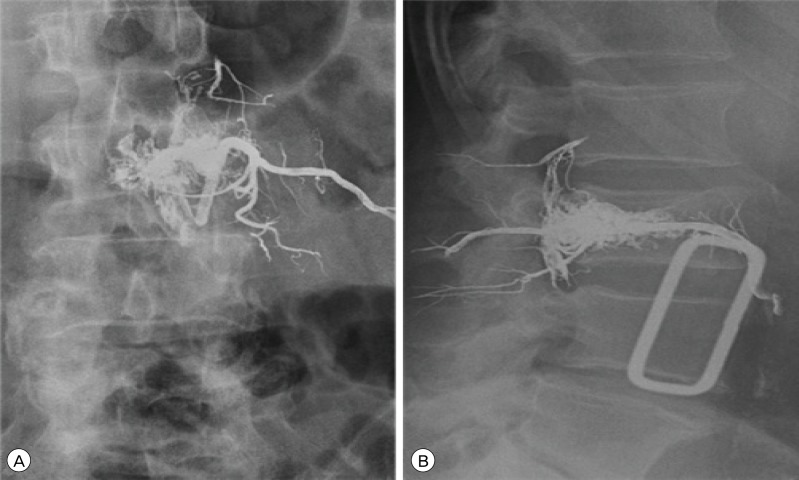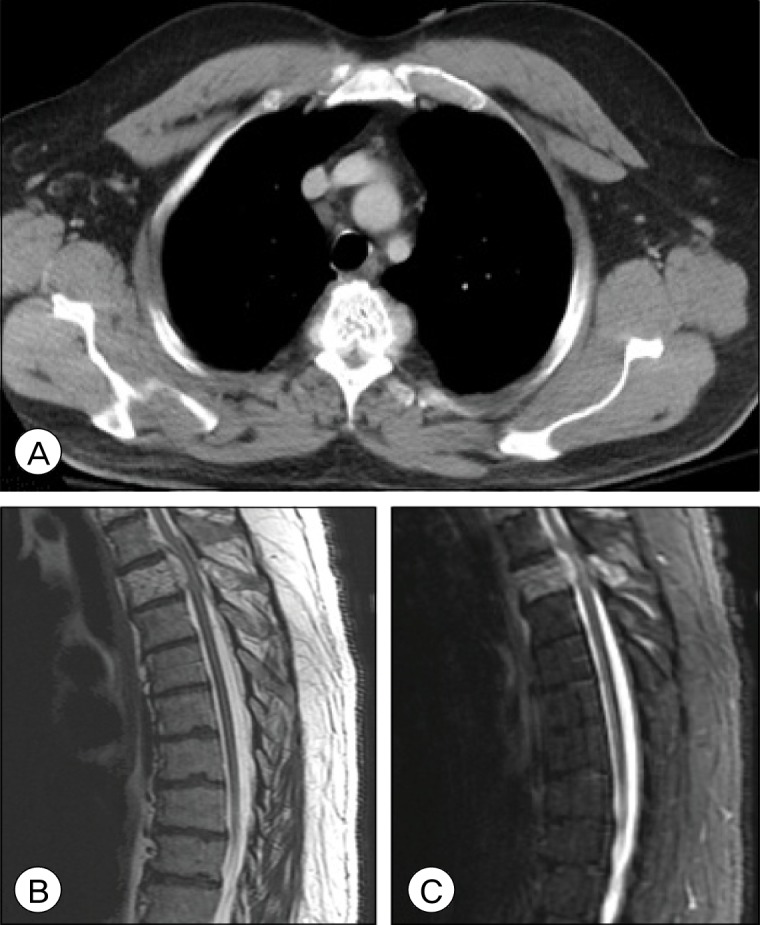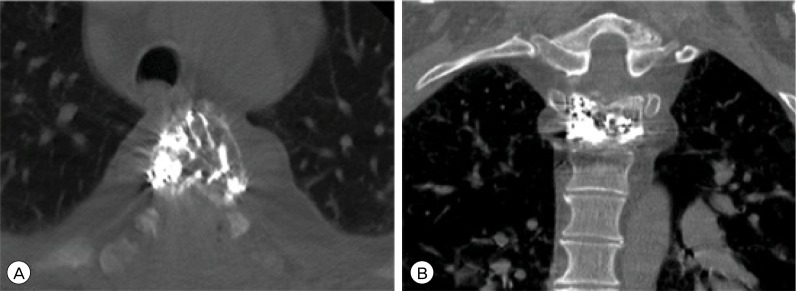J Cerebrovasc Endovasc Neurosurg.
2013 Dec;15(4):320-325. 10.7461/jcen.2013.15.4.320.
Intra-arterial Onyx Embolization of Vertebral Body Lesions
- Affiliations
-
- 1Department of Radiology, Beth Israel Deaconess Medical Center and Harvard Medical School, Boston, MA, USA.
- 2Department of Neurological Surgery, Brigham and Women's Hospital and Harvard Medical School, Boston, MA, USA. bgross1@partners.org
- 3Division of Neurological Surgery, Beth Israel Deaconess Medical Center and Harvard Medical School, Boston, MA, USA.
- KMID: 1810792
- DOI: http://doi.org/10.7461/jcen.2013.15.4.320
Abstract
- While Onyx embolization of cerebrospinal arteriovenous shunts is well-established, clinical researchers continue to broaden applications to other vascular lesions of the neuraxis. This report illustrates the application of Onyx (eV3, Plymouth, MN) embolization to vertebral body lesions, specifically, a vertebral hemangioma and renal cell carcinoma vertebral body metastatic lesion.
Keyword
MeSH Terms
Figure
Reference
-
1. Acosta FL Jr, Dowd CF, Chin C, Tihan T, Ames CP, Weinstein PR. Current treatment strategies and outcomes in the management of symptomatic vertebral hemangiomas. Neurosurgery. 2006; 2. 58(2):287–295. discussion 287-95. PMID: 16462482.
Article2. Berkefeld J, Scale D, Kirchner J, Heinrich T, Kollath J. Hypervascular spinal tumors: Influence of the embolization technique on perioperative hemorrhage. AJNR Am J Neuroradiol. 1999; 5. 20(5):757–763. PMID: 10369341.3. Clarençon F, Di Maria F, Cormier E, Sourour NA, Enkaoua E, Sailhan F, et al. Onyx injection by direct puncture for the treatment of hypervascular spinal metastases close to the anterior spinal artery: Initial experience. J Neurosurg Spine. 2013; 6. 18(6):606–610. PMID: 23600580.
Article4. Elhammady MS, Wolfe SQ, Ashour R, Farhat H, Moftakhar R, Lieber BB, et al. Safety and efficacy of vascular tumor embolization using Onyx: Is angiographic devascularization sufficient? J Neurosurg. 2010; 5. 112(5):1039–1045. PMID: 19698039.
Article5. Fox MW, Onofrio BM. The natural history and management of symptomatic and asymptomatic vertebral hemangiomas. J Neurosurg. 1993; 1. 78(1):36–45. PMID: 8416240.
Article6. Hurley MC, Gross BA, Surdell D, Shaibani A, Muro K, Mitchell CM, et al. Preoperative Onyx Embolization of Aggressive Vertebral Hemangiomas. AJNR Am J Neuroradiol. 2008; 6. 29(6):1095–1097. PMID: 18372419.
Article7. Kim LJ, Albuquerque FC, Aziz-Sultan A, Spetzler RF, McDougall CG. Low morbidity associated with the use of NBCA liquid adhesive for preoperative transarterial emoblization of central nervous system tumors. Neurosurgery. 2006; 7. 59(1):98–104. discussion 98-104. PMID: 16823305.8. Krueger EG, Sobel GL, Weinstein C. Vertebral hemangioma with compression of spinal cord. J Neurosurg. 1961; 5. 18:331–338. PMID: 13754556.
Article9. Lang EK, Sullivan J. Management of primary and metastatic renal cell carcinoma by transcatheter embolization with iodine 125. Cancer. 1988; 7. 62(2):274–282. PMID: 3383128.
Article10. Laredo JD, Reizine D, Bard M, Merland JJ. Vertebral hemangiomas: Radiologic evaluation. Radiology. 1986; 10. 161(1):183–189. PMID: 3763864.
Article11. Manke C, Bretschneider T, Lenhart M, Strotzer M, Neumann C, Gmeinwieser J, et al. Spinal metastases from renal cell carcinoma: Effect of preoperative particle embolization on intraoperative blood loss. AJNR Am J Neuroradiol. 2001; 5. 22(5):997–1003. PMID: 11337348.12. Smith TP, Koci T, Mehringer CM, Tsai FY, Fraser KW, Dowd CF, et al. Transarterial embolization of vertebral hemangioma. J Vasc Interv Radiol. 1993; Sep-Oct. 4(5):681–685. PMID: 8219564.
Article13. Sundaresan N, Galicich JH, Lane JM, Bains MS, McCormack P. Treatment of neoplastic epidural cord compression by vertebral body resection and stabilization. J Neurosurg. 1985; 11. 63(5):676–684. PMID: 4056870.
Article14. Sundaresan N, Scher H, DiGiacinto GV, Yagoda A, Whitmore W, Choi IS. Surgical treatment of spinal cord compression in kidney cancer. J Clin Oncol. 1986; 12. 4(12):1851–1856. PMID: 2431111.
Article15. Sundaresan N, Choi IS, Hughes JE, Sachdev VP, Berenstein A. Treatment of spinal metastases from kidney cancer by presurgical embolization and resection. J Neurosurg. 1990; 10. 73(4):548–554. PMID: 2398386.
Article16. Swanson DA, Orovan WL, Johnson DE, Giacco G. Osseous metastases secondary to renal cell carcinoma. Urology. 1981; 12. 18(6):556–561. PMID: 7314355.
Article17. Thakur NA, Daniels AH, Schiller J, Valdes MA, Czerwein JK, Schiller A, et al. Benign tumors of the spine. J Am Acad Orthop Surg. 2012; 11. 20(11):715–724. PMID: 23118137.
Article
- Full Text Links
- Actions
-
Cited
- CITED
-
- Close
- Share
- Similar articles
-
- Hairball-Like Migration of “Onyx Threads” into the Draining Vein during Transarterial Embolization of a Dural Arteriovenous Fistula: A Case Report and Experimental Validation
- Complication Associated with Onyx Embolization of Spinal Cord Arteriovenous Malformation
- Foreign body granuloma reaction after endovascular therapy of an unruptured right frontal arteriovenous malformation
- Endovascular Treatment of Scalp Arteriovenous Fistula: Transvenous Onyx Embolization with Balloon Occlusion
- Preoperative Embolization of Cerebellar Hemangioblastoma with Onyx: Report of Three Cases







